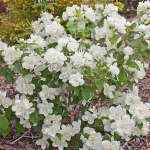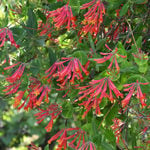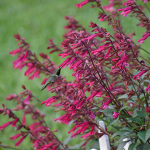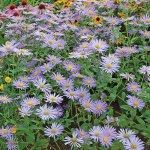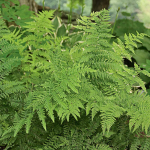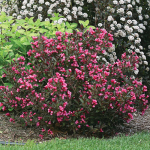Product Details
The name Hibiscus acetosella ‘Mahogany Splendor’ is no exaggeration. This remarkable foliage and contrast plant brings heavily serrated, gleaming garnet leaves to the sunny summer and late-season garden. They resemble the deeply dissected form familiar in some Japanese Maples. The vigorous, drought- and heat-tolerant plants will grow high (to roughly 6’) and wide (to 3’), and they’ll continue gaining in size until hard frost. ‘Mahogany Splendor’ responds beautifully to pruning and the foliage makes a fabulous addition to bouquets. To use the stems for contrasting color and distinctive leaf form in your bouquets, sear the stem ends as soon as possible in boiling water for 5-7 seconds, then enjoy in a vase for days.
Hibiscus is a huge genus of more than 200 species, practically all native to tropical areas. Some species are grown for their big bright flowers while Hibiscus acetosella is grown for its foliage. Give them moist, well-drained soil and plenty of heat and sun. Stems will die down to the ground over winter in colder climates.
For information on growing and care, click Growing Guide.
Shipping
HOW PLANTS ARE SHIPPED
The size of the plants we ship has been selected to reduce the shock of transplanting. For some, this means a large, bareroot crown. Others cannot travel bareroot or transplant best if grown in containers. We ship these perennials and annuals in 1 pint pots, except as noted. We must point out that many perennials will not bloom the first year after planting, but will the following year, amply rewarding your patience. We ship bulbs as dormant, bare bulbs, sometimes with some wood shavings or moss. Shrubs, Roses, vines, and other woody plants may be shipped bareroot or in pots. The size of the pot is noted in the quick facts for each item.
WHEN WE SHIP
We ship our bulbs and plants at the right time for planting in your area, except as noted, with orders dispatched on a first-come, first-served basis by climate zone. We also ship a wide range of containers and planters, tools, supplies, fertilizers, garden wear, garden decor items, as well as indoor decorations like wreaths and dried bouquets when available. Estimated dates for shipping are indicated in the green Shipping Details box for each item. Please supply a street address for delivery. Kindly contact us with two weeks notice, if you'll be away at the expected time of delivery.
OUR GUARANTEE
We guarantee to ship plants that are in prime condition for growing. If your order is damaged or fails to meet your expectations, we will cheerfully replace or refund it. Please contact our Customer Service Department at 1-800-503-9624 or email us at [email protected]. Please include your order number or customer number when contacting us.
Reviews
Average Customer Rating:
 (2 Reviews)
Write a Review
(2 Reviews)
Write a Review
Sort by:
Huge and heart-stopping 
PAMELA EVANS from Kansas City, MO
Perfect! 
A viewer from Shreveport, LA
11 of 12 people found this review helpful. Do you? yes no Certified buyer
Growing guide
Most gardeners begin their love of gardening with annuals. Planting them is therefore thought to be child’s play, and that is true, so long as one follows certain simple but sometimes overlooked practices. Here are the essential steps for getting annual plants and other seedlings off to a good start.
Soil Preparation: Plants grow best in soil that has been loosened before planting to allow ready penetration of oxygen and water. A shovel, spade, or rototiller works well for breaking ground, turning the soil, and chopping up clods; a rototiller comes in handy for preparing a large area. Spread 3–4″ of organic matter (such as compost, peat moss, well-rotted manure, or leaf mold) over the area to be prepared, then turn it into the soil to a depth of approximately 10–12″. We get good results by digging down just one shovel’s depth, and unless your soil requires extensive rehabilitation, you probably will, too.
Planting: Your plants are fresh from the protected environment of a greenhouse and they need a gradual introduction to direct sun and stiff breezes before planting. Set plants outdoors in a sheltered, lightly shaded spot, increasing their exposure to sun and wind each day for up to 3 days.
Before planting, check the moisture of the potting mix. Water thoroughly if it's dry. Then dig a hole just slightly larger than the pot. Remove the plant from the pot by grasping the rim, turning the pot upside down, and tapping it against the heel of your hand. If the plant is root-bound (the root ball matted with roots to the point that they all but obscure the potting mix), gently break up the sides of the ball with your thumbs and tease apart roots that are circling at the bottom. This operation encourages the roots to grow out of the potting mix and into the surrounding soil. Set the root ball in the hole so that the top of the ball is level with the surface of the soil. Then push soil around and just over the top of the root ball, firm the soil, and give the plant a thorough soaking to settle the soil.
Watering: The key to getting a new plant off to a good start is moisture. Water thoroughly after planting, and keep a close eye on the plant over the following week. If you see it wilt on a hot, sunny day, check the soil to a depth of about 1″. If dry, water thoroughly. If the soil below the surface is moist to the touch, don’t water. The plant is probably wilting because the roots are unable to supply the top with sufficient moisture even though the soil is damp. The remedy is to contrive some means of shading the plant. Within a week or so, the roots should catch up, and you can remove the shading.
After the first week, give a new plant a good soaking once a week during summer, unless there is more than 1″ of rainfall per week. Established plants can get by on less water, but most grow best if the soil remains evenly moist. Please note that more water is not better. When in doubt, don’t water.
Fertilizing: When plants are established, we recommend feeding monthly with a bloom-boosting fertilizer (15-30-15).
Gardening in Containers: Plants in containers need special care. They dry out more quickly than plants in the ground; in the heat of the summer, you may have to water them daily. Because of the need for frequent watering, nutrients soon wash out the bottom of the pot. We recommend you use a potting mix specifically designed for use in containers, and incorporate a timed-release fertilizer into the potting mix before you add the mix to the container. In addition, to keep annuals growing and flowering in summer, we recommend feeding monthly with a bloom-boosting fertilizer (15-30-15). Finally, to look their best, most plants in containers need regular grooming. Remove spent flowers regularly and prune vigorous growers to keep them in check.

